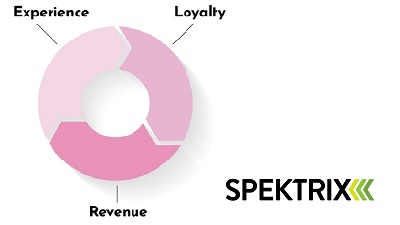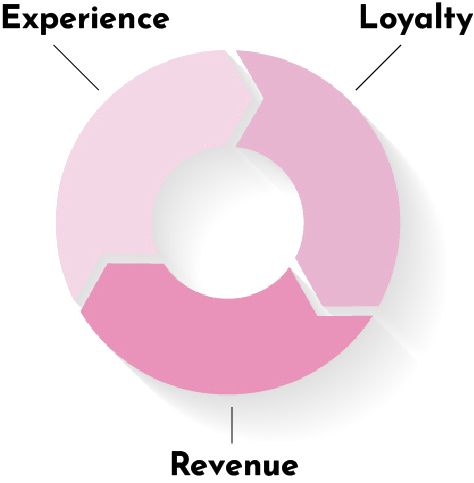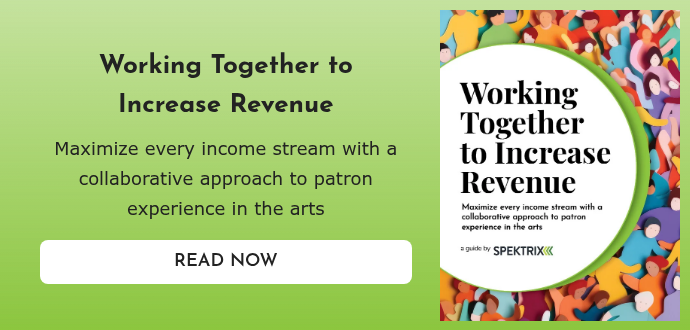4 min read
How a Great Audience Experience Builds Multiple Streams of Income
 Janie Dickerson
September 19, 2023
Janie Dickerson
September 19, 2023

How to build multiple streams of income across your theater or arts center through a cross-departmental approach to audience experience.
This blog offers ideas to increase ticket sales. It also encourages you to look beyond butts in seats and consider how you can boost revenue from other activity, right across your business. When you build a great relationships with your patrons, they're more likely to purchase additional tickets, spend time and money in your building, and donate to your fundraising campaigns.
An affinity-focused approach to income streams
Live performance offers a uniquely thrilling, immediate and memorable experience. But leisure time is precious, and there’s a lot of competition for audiences’ time and money. With so much on-demand content out there, offering curated, relevant entertainment at the touch of a button, it’s vital that your experience stands out - not just the central performance, but the whole event.
Every positive interaction with your organization - whether online, in the performance space or front of house - builds a patron’s affinity with your brand or work. Negative interactions - whether experienced directly or reported via social media or other publicchannels - can reduce that affinity, and in turn reduce the likelihood of future revenue from that audience member.
No doubt there are times when it feels impossible to create change, devise improvements or respond to feedback. But when you see the direct correlation between experience, affinity and revenue, ask yourself instead: Can you afford not to do it?

To build an affinity-centered revenue plan, the first step is to change how you think about your budgets. It’s easy to think about your streams of income by department - marketing, fundraising and concessions revenue - and to set targets, plan campaigns or measure success in siloes. Instead of looking at departmental income, think about the different ways in which patrons spend money in your organization, and how their engagement differs across each stream of income.
Earned income
The income you receive from your primary sales activity - usually tickets to your events
Contributed income
Income from donations, usually given by loyal customers as a gift, or in exchange for a unique experience
Secondary spend
Income from additional revenue streams across your organization - merchandise, catering, transit, ticket insurance and more
Recurring income
Payments that are likely to recur year on year, such as memberships or subscriptions
Understand audience experience and spending patterns
It’s easy to think that you know your audience. After all, you speak with them almost every day. But it’s important not to make assumptions, especially if they’re based on the most vocal or visible demographics among your visitors. Your ticketing system is a huge repository of behavioral data and insight, enabling you to dig deep into the price points and offerings that resonate most with audiences for particular genres or event types.
Combine ticket sales data with:
- Email engagement data, telling you when patrons are most likely to open or click on your communications
- Fundraising data, guiding the value and campaign you choose for your donation prompts
- Survey data, adding a layer of qualitative feedback to the information in your CRM
“It’s every single data point. What are people interested in? What are they asking for? What are they actually doing? What is our programming geared toward? So many of our buyers are new, most of the people who come to our performances have never been here before. So how do we turn you into a loyal buyer from the start, when you don’t even know who we are?” Brian Glass, Director of Marketing, Communications & Digital, Performing Arts Houston
So take a step back. Don’t start planning to increase revenue by asking what you can offer your audiences.
Start with asking why they come to your events, what they’ve historically bought, and how you can use that information to design new offers for them.
Design upsells that show your audiences that you understand their needs, and that you care about their comfort. Offer them multiple ways to engage across different income streams. Use ticketing and CRM data to understand when they book, what they’re likely to spend and who they attend with. A couple visiting on a date might have very different needs to a family or group of friends.
And finally, if you’re running qualitative audience surveys alongside quantitative data from your CRM system, make sure they’re segmented, relevant and short. You might want to know everything all at once, but your audiences won’t want to complete a long survey, and you probably won’t want to process all that data. Keep it simple - don’t forget they’re doing you a favor!
Considering multiple income streams at every step of the audience experience
Bring together marketing, ticketing and fundraising teams for just a few hours to begin mapping out simple customer journeys. Think about the balance of earned, contributed and recurring income, and about ways to increase secondary spend with every visit. By extending the right ask to the right patrons, at the right time, you’ll not only boost your revenue, you’ll also create a higher quality, more connected customer experience.
Online experience
Does your website reflect your brand? It’s often where patrons will have their first interaction with you, so make sure your creativity, passion and helpfulness are apparent, right through their website visit and purchase pathway.
Online, offer a choice of spending routes, enabling patrons to easily find the journey that’s right for them - and building your bank of data at the same time.
Pre-visit experience
Can you take the stress out of travel? A simple pre-visit email with reminders about timings, directions and ticket collection can make all the difference to patrons’ experience.
Pre-visit, encourage secondary spend with the opportunity to pre-order concessions, reserve parking, or upgrade to a premium experience.
Front of House experience
Does your team know who’s coming through the door? If you know who’s booking for your events - whether they’re frequent attenders, first-time visitors, major donors or access customers - you can prepare to welcome them individually and have everything ready to meet their needs.
Front of House, continue to secondary spend with enticing, relevant catering or merchandise.
Event experience
Can audiences immerse themselves in the performance? It’s easy to be distracted by uncomfortable seating, temperature, or wondering when there’ll next be a bathroom break. Ask patrons about their experience so you can improve your operations or communications for the next audience.
This is where the magic happens! The event is what’s most likely to inspire future earned income and contributed revenue. That’s the work of the creative team - your job is to ensure nothing detracts from that experience.
Post-visit experience
When will your patrons be back? Follow up promptly to thank them for coming, encourage feedback, and invite them to visit again - helping them know you’re addressing any concerns, and inspiring them to revisit a great experience, again and again.
Post-visit, target messaging based on previous behaviors to prompt further ticket sales, invite donations, or promote subscriptions, memberships and other loyalty programs.
Work through every stage of your audience’s experience, and think collaboratively about how to offer the most relevant opportunities at every stage. At Performing Arts Houston, for example, Setting up a Membership Program for the Performing Arts was a project shared by marketing and development teams, helping them make a successful recovery from COVID and beat the benchmarks for reattendance and loyalty.
By taking a similar approach, starting with data, audience analysis and shared targets, you and your team will have the best chance of finding new, shared ideas for building multiple streams of income.
This is an edited extract from Working Collaboratively to Increase Revenue, a new resource published by Spektrix for theaters, performing arts centers and event organizers. Download your copy for more ideas to rebuild revenue through great audience experiences.
 Janie Dickerson (she/her) is an Account Executive at Spektrix
Janie Dickerson (she/her) is an Account Executive at Spektrix



